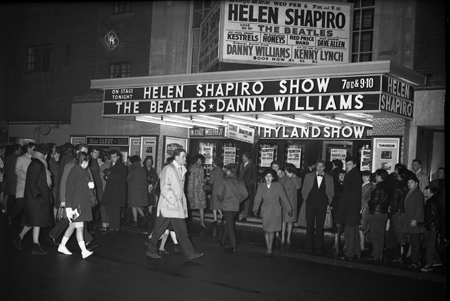Strike Up The Band
The Quarter Sessions Rolls are not perhaps where you would expect to find out about the musical side of Bedfordshire life however, brief glimpses can be found.
Our first glimpse is very much an aside to the main action of the criminal case. In 1841 Samuel Kendall of Wilshamstead reported a robbery from his house. As part of his evidence he explains his domestic arrangements. He lives alone except for his son who sleeps with him but who goes to his sister's for breakfast. The day he discovered the robbery was a Sunday; his son plays the clarinet at church and usually takes it with him to his sister's but forgot it that day and came back for it. [ref.QSR1841/2/5/10-12]
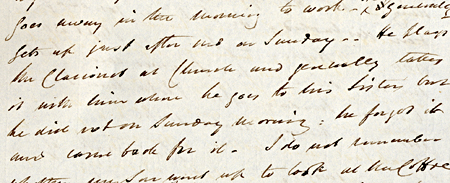
Today we are used to thinking of church music being focused on the pipe organ but this mention makes us think about the church music of the late 18th and early 19th centuries, which was generally very different. Organs had been in churches until the 17th century but were removed during the reformation. By the 18th century music had come back into churches. Charles Wesley wrote over 6,000 hymns before his death in 1788 and singers and bands were formed and supplied with music and instruments by the churchwardens of many parishes. Barton churchwarden's account book from 1834 is just one example of this type of expenditure. [Ref. P21/5/1 – more on these accounts can by found on our You Tube channel ].

These entries from the 1830s and 40s put us in mind of Thomas Hardy's Under the Greenwood Tree in which the Mellstock Quire are disbanded when the vicar introduces an harmonium. The Bedfordshire records also show the reintroduction of the organ at the expense of church bands. At Cople an organ belonging to Rev H E Havergal was installed in 1857; Shillington's organ was installed the same year. One churchwarden's account book from Wrestlingworth contains in 1838 repairing music instruments and in 1868 accounts for the new organ [Ref.P52/5/2].
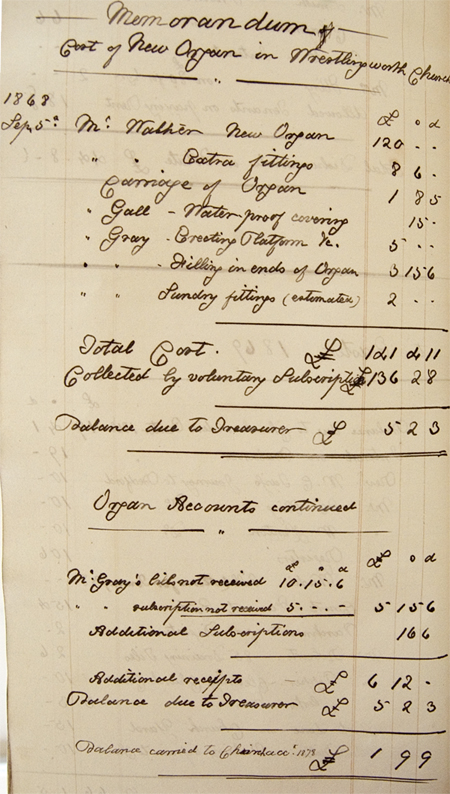
However, the rise of the church organ was not the end of local village bands. One of our favourite cases is that of the Eaton Bray riot when the band turn out to play during the riot. Their instruments are listed in detail in the evidence. In QSR1846/3/5/24-26,35-50 Thomas Sinfield, the police constable says 'The band was playing all the way from the time they were drinking on the Green until they left them … The men playing in the band were Joseph Roe, James Roe, John Lugsden and William Lugsden. They had no drum, Joseph Roe was playing the key bugle, James Roe and John Lugsden were playing trombones, and William Lugsden a clarinet. They had been playing in the morning while Gadsden Fountain was in the stocks. He put Fountain in the stocks about 5.30am. The same men played then, together with Jesse Thorn playing the drum and Edward Brown a key bugle. They began playing about 9am.'
In the Church of England wind and string instruments may have been common however, in the 19th century, there was a move towards silver and brass bands bolstered by the introduction of a competitive element and by their use by the Salvation Army [ref.Z1306/75/21/15 Luton Salvation Army band at Wardown Park, Luton, 1906].

It is somewhat surprising to learn that in the 1880s Dunton, which had a population of 477 in 1881 and only 434 in 1891, had it's own Drum and Fife band [Ref.QSR1888/3/5/4].
The 19th century saw the development of a number of different instruments among them the English concertina, patented in 1829 and improved in 1844. The Quarter Sessions had at least two cases involving these instruments. In 1857 a Dunstable music shop owner accused two men, Peter Miller and Franz Bonbin, of obtaining a concertina by false pretences. The men brought a concertina into the shop when the shopkeeper, Edwin Bowen Donne, was away and the shopkeeper's wife exchanged it for a larger model on payment of 2 shillings. However, on his return to the shop Mr Donne felt that this did not cover the worth of the new instrument and had the men arrested. [Ref.QSR1857/3/5/3-4].
In 1896 Martha Hill of Luton accused her father, George Rowley, of stealing her concertina. George was acquitted even though he had taken the concertina and pawned it. Nor was it the first time George had been in trouble as he had a string of convictions dating back to when he was 10 years old. However he had left a note 'Exhibit A' to say that he had borrowed the music [Ref.QSR1896/3/5/2].

As well as repairs to instruments there is evidence of their local manufacture. In 1843 a quantity of brass was stolen from Kilpin's shop in Bedford. In his evidence Thomas Skerman of St Paul Bedford, explained that he is a brazier employed by Messrs Kilpin and Son of Bedford, ironmongers. They always have a great quantity of unmanufactured copper and other metals about the workshop. There was some copper in the braziers shop about a week ago which he cut out for a musical instrument called a seraphim. Yesterday March 27th Mr William Kilpin brought him some pieces of copper which he knew to be a portion of the copper cut out for the musical instrument. It is the copper now produced by Lamb the constable. [Ref.QSR1843/2/5/11/a]
Of course music in Bedfordshire didn't cease in the 19th century. The Bedfordshire Federation of Women's Institutes Music and Arts sub-committee began in 1924 and changed to Music and Drama in 1928 [Ref.X939/2/6] and in the 1920s Bedford hosted an Eisteddfod in which local schools and choirs competed.
When the Second World War came to Bedford so did the BBC bringing with them the BBC Symphony Orchestra [BTNeg1940/1 shows Sir Adrian Boult and Yehudi Menuhin at Bedford School in 1944].
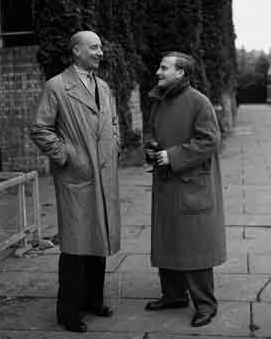
The war also brought us Glenn Miller [ref.BTNeg1886/2] who set off on his last journey from Twinwood airfield on 15 December 1944.
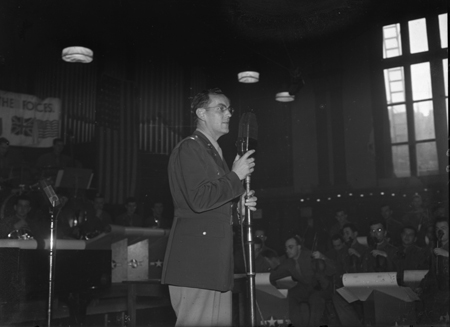
In 1963 Helen Shapiro topped the bill at The Granada backed by a little known group called The Beatles (BTNegF288/12); I wonder what happened to them?
